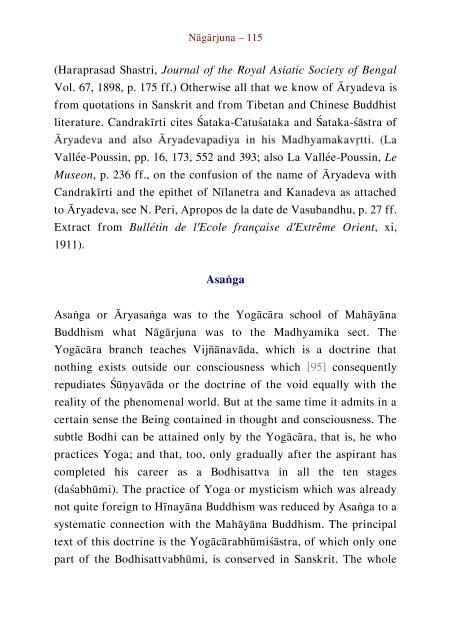Literary History of Sanskrit Buddhism
A study by J. K. Nariman of Sanskrit Buddhism from the Early Buddhist Tradition up to the Mahayana texts proper.
A study by J. K. Nariman of Sanskrit Buddhism from the Early Buddhist Tradition up to the Mahayana texts proper.
You also want an ePaper? Increase the reach of your titles
YUMPU automatically turns print PDFs into web optimized ePapers that Google loves.
Nāgārjuna – 115<br />
(Haraprasad Shastri, Journal <strong>of</strong> the Royal Asiatic Society <strong>of</strong> Bengal<br />
Vol. 67, 1898, p. 175 ff.) Otherwise all that we know <strong>of</strong> Āryadeva is<br />
from quotations in <strong>Sanskrit</strong> and from Tibetan and Chinese Buddhist<br />
literature. Candrakīrti cites Śataka-Catuśataka and Śataka-śāstra <strong>of</strong><br />
Vallée-Poussin, pp. 16, 173, 552 and 393; also La Vallée-Poussin, Le<br />
Museon, p. 236 ff., on the confusion <strong>of</strong> the name <strong>of</strong> Āryadeva with<br />
Candrakīrti and the epithet <strong>of</strong> Nīlanetra and Kanadeva as attached<br />
to Āryadeva, see N. Peri, Apropos de la date de Vasubandhu, p. 27 ff.<br />
Extract from Bullétin de l'Ecole française d'Extrême Orient, xi,<br />
1911).<br />
Asaṅga<br />
Asaṅga or Āryasaṅga was to the Yogācāra school <strong>of</strong> Mahāyāna<br />
<strong>Buddhism</strong> what Nāgārjuna was to the Madhyamika sect. The<br />
Yogācāra branch teaches Vijñānavāda, which is a doctrine that<br />
nothing exists outside our consciousness which [95] consequently<br />
repudiates Śūṇyavāda or the doctrine <strong>of</strong> the void equally with the<br />
reality <strong>of</strong> the phenomenal world. But at the same time it admits in a<br />
certain sense the Being contained in thought and consciousness. The<br />
subtle Bodhi can be attained only by the Yogācāra, that is, he who<br />
practices Yoga; and that, too, only gradually after the aspirant has<br />
completed his career as a Bodhisattva in all the ten stages<br />
(daśabhūmi). The practice <strong>of</strong> Yoga or mysticism which was already<br />
not quite foreign to Hīnayāna <strong>Buddhism</strong> was reduced by Asaṅga to a<br />
systematic connection with the Mahāyāna <strong>Buddhism</strong>. The principal<br />
text <strong>of</strong> this doctrine is the Yogācārabhūmiśāstra, <strong>of</strong> which only one<br />
part <strong>of</strong> the Bodhisattvabhūmi, is conserved in <strong>Sanskrit</strong>. The whole


















